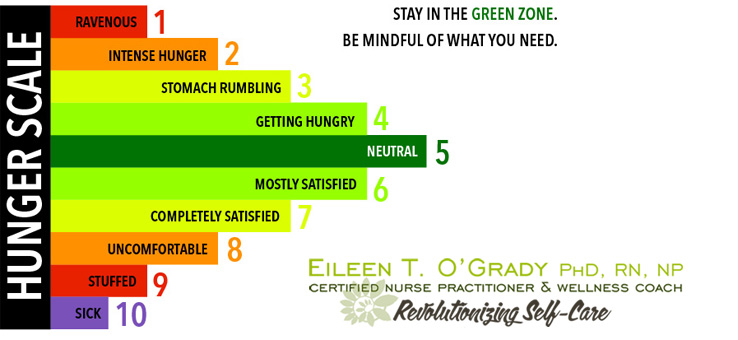Banishing Hangry: Finding Freedom by Creating Space
Hangry=Hungry + Angry
An empty stomach is not a good political adviser.
Albert Einstein
A client I am working with has been struggling with her weight since adolescence. Determined to do something about it, she committed to interrupting her pattern of living and eating. Right away, she became aware that her eating habits were not aligned with her body signals. Her pattern was to grab whatever was grab-able at 6 am and eat on the way to work. She had a high pressure job in a rural area with no access to food. Unless a co-worker brought in sweets, she would not eat until she arrived home 10 hours later. Once home, she would quickly consume large amounts of comfort food, often to the point of feeling sick. She was stuck in a cycle of starving, over-eating, and repenting.
She started using the 10 point hunger scale and now assigns herself a number so that she stays between a “4” and “6” throughout the day to avoid the extremes. She has noticed that if she drops below a “2”, she enters the “hangry “ zone, which causes her to overeat (past an “8”). By avoiding getting too hungry and really tuning into her body, she is able to stop eating before she is uncomfortable. We can’t manage what we don’t measure and what we measure, improves.
Now down 20 lbs, she remedied her HANGRY condition by eating regular meals, stocking her office with real food and when her body tells her she’s hungry, she eats. She reports less hunger, the ability to better regulate what she is eating and feels empowered around food. She has a strong sense of purpose and loves to learn, so she is directing these strengths at responding to hunger cues and changing her relationship with food. She is framing this new way of living as something that matters a lot to her. She has become her own wise council by creating a space, a pause between the stimulus and her response to it, so she can be in the great land of choice. She has entered the land of true freedom.
For more information, here’s a summary of a study on parents who display high levels of disinhibited eating, especially when coupled with high dietary restraint, on a child’s eating patterns.
Between stimulus and response there is a space. In that space is our power to choose our response. In our response lies our growth and our freedom. Viktor Frankl
Hunger Scale image by Lawrell Wenzel


Thank you for this pearl! You’ve summed up the dilemma and the choice beautifully. I love the way you provided an accessible tool and demonstrated its use. Clear as a bell. You’re awesome!
I really like using a scale for hunger. I think I often, I over eat because I am so used to assuming; I always have to be full to be satisfied. This of course is not the case, but it’s hard to make that determination with out properly visualizing the different levels of hunger. Wonderful Pearl!
Great advice and so necessary with all the quick-grab food options that surround us. Thanks for showing us how it pays to plan a little.
Many of us would benefit from following a program such as this
Hunger scale is an excellent tool. I am going to start utilizing this in my practice. Outstanding article! Thank You!